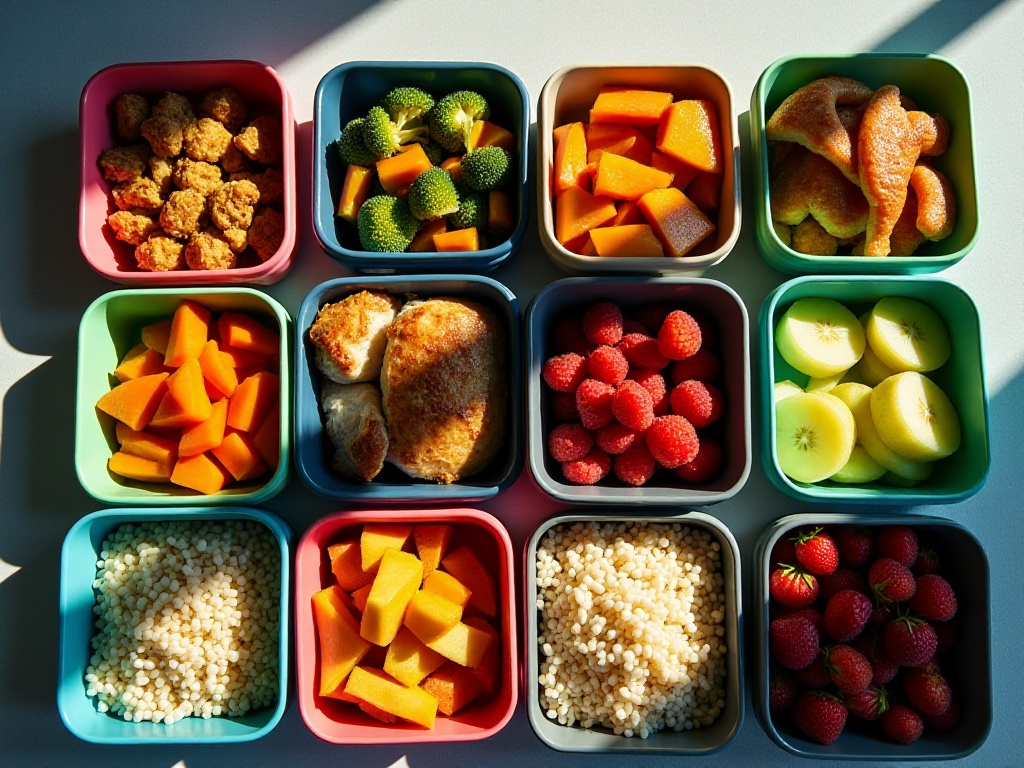
Introduction
Hi everyone! I'm Little V, a foodie blogger who loves delicious food while staying healthy. Recently, I've noticed many friends struggling with "healthy eating." Some friends say "I only eat boiled vegetables and salads, feeling completely drained of energy," while others complain "I've starved myself like a hamster, but the number on the scale hasn't budged." Based on my experience over the past few years, healthy eating isn't actually that difficult - the key is finding the right approach. Today, let me share from a seasoned foodie's perspective how to improve your body through simple dietary adjustments.
Nutrition Basics
When it comes to healthy eating, many people's first reaction is "need to diet" or "need to eat less." But! This thinking is completely wrong! The core of healthy eating isn't about "eating less" at all, but about "eating smart." So the question is, what does truly "eating smart" mean?
First, we need to understand the basic nutritional composition our bodies need. According to the latest nutritional research, carbohydrates should make up 45-65% of our total daily calories. But here's a super important point - not all carbs are good carbs! Quality carbohydrates are best chosen from whole grains, like brown rice, quinoa, whole wheat bread, etc. These foods not only provide sustained energy but are also particularly rich in dietary fiber.
Speaking of dietary fiber, I really need to elaborate. Many people might not know that dietary fiber is practically a intestinal cleaner! It not only helps promote intestinal movement but also allows good bacteria to settle in the gut. Recent studies show that people who consume 25-30 grams of fiber daily can reduce their risk of cardiovascular disease by 30% - this data is really shocking!
Now I unfailingly have a bowl of oatmeal every morning, topped with various nuts and fresh fruits - it's not only nutritious but also particularly filling. And recently I discovered an amazing way to eat it: soaking oats in yogurt overnight. The next morning you get super creamy overnight oats - the texture is absolutely amazing!
Protein intake is also crucial in healthy eating. Many women, in order to lose weight, often excessively restrict their protein intake - this is a huge mistake! Appropriate amounts of quality protein not only won't make you gain weight but will help maintain muscle mass and increase basic metabolism. Generally speaking, you need 1.2-1.6 grams of protein per kilogram of body weight daily. For example, I weigh 50 kilograms, so I need to consume 60-80 grams of protein daily.
As for fat, although it's the most calorie-dense nutrient, it absolutely shouldn't be completely avoided. Healthy fat intake is particularly important for maintaining hormonal balance, protecting organs, and absorbing fat-soluble vitamins. I personally highly recommend healthy fat sources like olive oil, avocados, and nuts. They not only provide essential fatty acids but also make food more delicious!

Practical Guide
After covering the theory, let's talk about something practical - how to actually implement healthy eating.
First is ingredient selection. I highly recommend the "rainbow diet" method, which is simple and effective. Specifically, it means having vegetables and fruits of various colors on your plate. Red tomatoes are rich in lycopene, orange carrots are rich in carotene, purple eggplants are rich in anthocyanins, green broccoli supplements folic acid and vitamin C... Different colors represent different nutrients.
Now every time I go to the supermarket, I deliberately choose vegetables of different colors. For example, last week I bought purple cabbage, yellow bell peppers, tomatoes, and broccoli. Simply stir-frying them at home provides balanced nutrition and looks particularly appetizing. Plus, I've found that the more colorful the plate, the better it looks when posting photos on social media - it's incredibly photogenic!
Speaking of ingredient selection, I also want to particularly emphasize seasonality. Choosing seasonal ingredients is not only fresher and cheaper but also has higher nutritional value. For example, eat more root vegetables in winter, like radish, yam, potatoes; in spring, eat more tender sprouts like bean sprouts, chives, bamboo shoots.
Cooking methods are also an important part of healthy eating. Many people think healthy eating means boiling or steaming only, but this view is too narrow. Appropriate frying and stir-frying are actually fine - the key is controlling oil amount and heat. One cooking method I particularly like is "dry frying," which means slow frying with a non-stick pan over low heat. This maintains the texture of ingredients without consuming too much oil.

Practical Tips
At this point, some friends might say: "I understand the principles, but I just can't do it!" Don't worry, let me share some particularly useful tips.
The first tip is preparation in advance. Now I spend an hour every weekend doing food prep. Cut and portion fruits, wash and box vegetables, freeze meat in small portions. This way, when you want to eat healthy, ingredients are ready to go, which is particularly convenient. Plus, this advance preparation can avoid food waste since everything has a clear consumption plan.
The second tip is gradual progress. Don't expect to completely change your eating habits at once - that's likely to lead to giving up. You can start by changing one meal, like making breakfast healthier first. Once you're used to that, gradually expand to other meals.
The third tip is finding suitable substitutes. For example, I really love chips but worry about consuming too much oil. Later I discovered I could substitute them with roasted seaweed or homemade vegetable chips, which satisfies the craving for something salty and crispy without consuming too many calories.
The fourth tip is keeping records. Now I use a phone app to record daily food intake, which not only clearly shows what I've consumed but also helps quickly identify if nutrition is balanced. Plus, the recording process itself is a form of constraint that makes people more mindful of food quality.
Another particularly important tip is learning to enjoy food. Healthy eating doesn't mean completely giving up delicious food. For example, one of my favorite dishes is pan-seared salmon with quinoa salad - it's not only highly nutritious but also particularly simple to make. Salmon is rich in omega-3 fatty acids, quinoa provides quality carbs and protein, and when combined with various colorful vegetables, it's a perfect combination of nutrition and flavor.

Summary and Outlook
Through today's sharing, I hope everyone can understand that healthy eating is actually a lifestyle, not a constraint. It's not just about figure, but more about our physical and mental health. Like growing flowers, today's efforts might not show immediate results, but as long as you persist, beautiful flowers will definitely bloom.
Remember, there's no standard answer for healthy eating - the key is finding what works for you. It might feel a bit difficult at first, but as time goes on, you'll find yourself getting more and more proficient, and might even fall in love with this healthy lifestyle.
Finally, I want to say that healthy eating isn't a solo performance but something that requires our collective effort. I hope through today's sharing, more people can realize the importance of healthy eating and join this healthy living movement together.
What do you think is the biggest challenge in practicing healthy eating? Welcome to discuss with me in the comments. Next time we'll talk about how to maintain regular exercise during workdays - remember to follow me!
Next
Smart People's Nutrition Management Tips for Effortless Health and Fitness
A comprehensive guide to healthy eating and nutrition, covering balanced diet composition, healthy eating habits, and practical tips. Detailed information on choosing carbohydrates, proteins, healthy fats, and strategies for diverse fruit and vegetable intake
Done Being a Nutrition Novice? This Comprehensive Nutrition Guide Will Help You Eat Scientifically Starting Today
A comprehensive guide exploring core principles of balanced nutrition and healthy eating, including nutritional optimization advice, scientific dietary methods, and practical meal management tips to help readers establish healthy eating habits
A Nutritionist Tells You: This is How to Eat Healthy Without Too Much Hassle - I've Been Practicing for 3 Years
A comprehensive guide to healthy eating and nutrition improvement, covering dietary principles, habit formation, and practical tips on whole grain selection, fruit and vegetable combinations, and protein intake for a balanced diet
Next

Smart People's Nutrition Management Tips for Effortless Health and Fitness
A comprehensive guide to healthy eating and nutrition, covering balanced diet composition, healthy eating habits, and practical tips. Detailed information on choosing carbohydrates, proteins, healthy fats, and strategies for diverse fruit and vegetable intake

Done Being a Nutrition Novice? This Comprehensive Nutrition Guide Will Help You Eat Scientifically Starting Today
A comprehensive guide exploring core principles of balanced nutrition and healthy eating, including nutritional optimization advice, scientific dietary methods, and practical meal management tips to help readers establish healthy eating habits

A Nutritionist Tells You: This is How to Eat Healthy Without Too Much Hassle - I've Been Practicing for 3 Years
A comprehensive guide to healthy eating and nutrition improvement, covering dietary principles, habit formation, and practical tips on whole grain selection, fruit and vegetable combinations, and protein intake for a balanced diet
